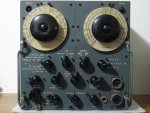We had a couple crates of World War Two naval radar counter-measures stuff hidden away in our little annex warehouse. Being the curious squirrel, I had them taken out, opened and dusted off, much like the S-36A that I previously described.
Now, these radios are mysteries to me, tho its perfectly clear what there missions were- One was was an RDO receiver with its assorted wave traps-- the other, its companion (?) jamming transmitter, a TDY.
We had all the manuals, but my curiosity was how, where and why they were deployed.
Bikini/Cross Roads tests? their crates had certain tell-tale markings, but no one could say.....
- Anyone familiar with them ?
We only powered up the receiver; it had an assortment of plug-in tuning elements that allowed the unit to receive ~50 to 3500 MHz. Its front end used a 1N21 detector (yes, a diode) but it was surprisingly sensitive. With a small dish antenna we could DX all the lunch room microwave ovens on our mesa top. The TDY contained a mystery magnetron, but no one felt adventurous enuff to turn it on.
The RDO receiver is the Navy version of the AN/APR-4 I mentioned in my previous post. In fact it uses the same tuning modules as the AN/APR-1 and AN/APR-4. The RDO was made by E. H. Scott (APR-1 and -4 were not made by Scott, but rather various other vendors). The RDO is a bit more fancy than the APR-4, a bit more versatile, and a bit larger.
I have an RDO in my collection, I have the associated RDP Pan adapter and the SPR-2 receiver, but am minus the RDJ Pulse An and the various matching antennas / wavetraps / switches, etc. I have been looking for the ancillary gear for years, slowly filling out the set.
As for TDY, could you mean the TDY-1 jammer? The TDY was a NRL (Naval Research Laboratory) development eventually serially built by General Electric. The TDY or, later, TDY-1 would have been used as part of a shipboard suite along with the RDO receiver. The TDY-1 worked from about 110 MHz to about 780 MHz using a noise jamming technique. The magnetron in the TDY-1 you saw should have been either the 5J29 or the 5J32. If it was just a TDY jammer, slightly less common, the frequency range would have been a bit narrower, more like 350 to 800 MHz. The TDY also had a receiver section, and could be used to augment the RDO in detection and monitoring of enemy signals.
The RDO concept eventually became, through many steps, the AN/WLR-1 (pre H model) used on Navy ships until the 1980's.
As to how and where the RDO and TDY were deployed, they were developed in 1943 and on many major fleet assets starting from about early-mid 1944 on. Carriers, battleships, cruisers, primary secondary ships (such as headquarters ships), and selected destroyers would have had the set or been in line to receive them during their next major rework. Most other newer combatants would (if things went according to plan) receive the RDO suite combined with a different jammer. But, because RDO was more expensive and slower to arrive in numbers, many ships got the APR-1 or APR-4 instead. Most often the APR-1 I think, possibly as these became available as the APR-4 replaced them (APR-1) in air use.
The RDO without the TDY (but possibly with APT jammers) would also have been on a few aircraft, specially configured PBY Catalinas, PB4Y Privateer, etc. But honestly, RDO in such an application would have been rare, with most aircraft using the APR-1 or APR-4 suites.
While they were in time for operations in the ETO / Atlantic, and were used there, they really shined in the Pacific, with fleet operations against the Japanese Navy in the last year+ of the war. ALong with "normal" Navy surface actions they participated in various amphibious operations, from ship monitoring and denying radar use to enemy land based radars in the late Island Hopping campaigns.
On a related note, if you would like a good background on the development of such systems in the US, including all of the radios / systems we have discussed so far, look for "The History of US Electronic Warfare" by Alfred Price, Vol 1 covers the period in question, Vol 2 and Vol 3 cover later developments. I wish it were more detailed, but it gives one a good starting point to research from.
T!


